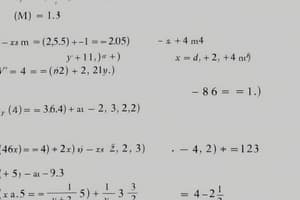Podcast
Questions and Answers
Which measurement tool is commonly used for measuring length?
Which measurement tool is commonly used for measuring length?
- Barometer
- Caliper (correct)
- Voltmeter
- Thermometer
What is the base quantity for measuring time in the International System of Units (SI)?
What is the base quantity for measuring time in the International System of Units (SI)?
- Day
- Second (correct)
- Hour
- Minute
Which prefix represents one million in the metric system?
Which prefix represents one million in the metric system?
- Deci-
- Mega- (correct)
- Kilo-
- Giga-
In kinematics, what does the term 'velocity' specifically refer to?
In kinematics, what does the term 'velocity' specifically refer to?
Which of the following forces acts on an object at rest when it remains stationary on a surface?
Which of the following forces acts on an object at rest when it remains stationary on a surface?
Flashcards
Standard Form
Standard Form
A way of writing numbers using powers of 10.
Measurement Tools
Measurement Tools
Devices used to measure physical quantities.
Base Quantity
Base Quantity
Fundamental units of measurement.
Prefixes
Prefixes
Signup and view all the flashcards
Kinematics
Kinematics
Signup and view all the flashcards
Study Notes
Standard Form
- Standard form is a way to write very large or very small numbers concisely.
- It involves expressing a number as a decimal number between 1 and 10 multiplied by a power of 10.
- This makes calculations and comparisons easier, particularly in scientific contexts.
- Example: 3,000,000 = 3 x 106
- Example: 0.00005 = 5 x 10-5
Measurement Tools
- Various tools are used to measure different physical quantities.
- Examples include rulers for length, scales for mass, stopwatches for time, thermometers for temperature, and protractors for angles.
- The precision and accuracy of a measurement depend on the tool used and how it is used.
- Digital tools often provide more precise readings than analog ones.
- Understanding the limitations of measurement tools is crucial for accurate data analysis.
Base Quantities
- Base quantities are fundamental physical quantities from which other derived quantities are defined.
- In the International System of Units (SI), the seven base quantities are length, mass, time, electric current, temperature, amount of substance, and luminous intensity.
- Each base quantity has a corresponding base unit.
- These base units are standardized and globally recognized.
- Defining base quantities is essential for unifying measurements across different disciplines and contexts.
Prefixes
- Prefixes are used to denote multiples or fractions of the base units.
- Examples include kilo- (103), centi- (10-2), milli- (10-3), and micro- (10-6).
- They make it easier to work with quantities that are significantly larger or smaller than the base unit.
- Using prefixes properly ensures accuracy in measurements and calculations.
- Different fields of science and engineering might use different and specialized sets of prefixes.
Kinematics
- Kinematics describes the motion of objects without considering the forces that cause it.
- Key concepts include displacement, velocity, and acceleration.
- Displacement is the change in position of an object.
- Velocity is the rate of change of displacement.
- Acceleration is the rate of change of velocity.
- These concepts can be represented graphically and mathematically to understand motion patterns.
- Equations of motion relate these quantities for constant acceleration scenarios.
- Examples include analyzing free-fall, projectile motion, or uniform circular motion.
Forces
- Forces are interactions that can change the motion of an object.
- Forces are vector quantities, meaning they have both magnitude and direction.
- They can cause an object to accelerate, decelerate, or change its direction of motion.
- Examples of forces include gravity, friction, normal force, and applied force.
- Net force is the vector sum of all forces acting on an object.
- Newton's Laws of Motion describe the relationship between forces and motion.
- Understanding forces is essential for analyzing and predicting the motion of objects in various situations, such as machines, vehicles or the behavior of particles.
- Applying forces is crucial for generating motion.
- Different types of forces have different effects, and their interplay determines the resultant motion.
Studying That Suits You
Use AI to generate personalized quizzes and flashcards to suit your learning preferences.




